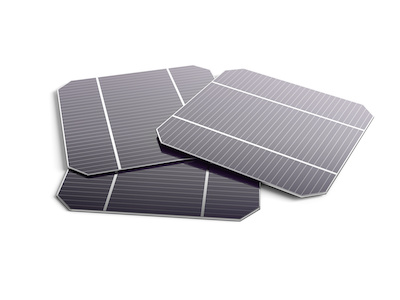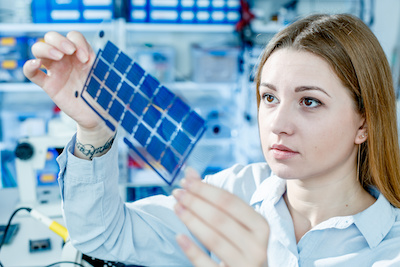With constant advances in technology as well as a growing market, you might be confused by the various types of solar panels available to you.

This shouldn’t stop you from looking further into solar paneling your home, however, as just a little research can provide you with the information you need to begin saving money with this alternative energy source.
What follows is a quick rundown of some of the most efficient solar panels available to home and small business owners.
What Types Of Solar Panels Are Available Today?
While there are various configurations based on its intended use, most solar panels you will encounter fall into a handful of categories. While this list is not exhaustive, these categories will include:
-
Polycrystalline Solar Cells
-
Monocrystalline Solar Cells
-
Amorphous Solar Panel
-
Thin Film Solar Panels
Polycrystalline Solar Cells
This is the first photovoltaic solar power cells which first appeared on the market during the early 1980s. They are made of square wafers of silicone that are cut from molded cubes. Photovoltaic systems based on this technology are shaped in the traditional square edge shape with a blue color.

These units have an efficiency rating of between 8 and 16-percent, with the newest technologies at the higher end. When comparing monocrystalline vs polycrystalline systems, these systems will come at a lower price point. This is due to a more simple refinement process, that is less wasteful than the methods used for monocrystalline systems.
Due to the lower efficiency rating of this type of cell, it will take more of them to generate the same power as other types. That will require more space. These cells have a shorter lifespan than monocrystalline systems do as well.
Monocrystalline Solar Cells
Photovoltaic solar power systems of this type use a refinement process that filters out all but the best silicone, which are more cylindrical in shape. The wafers are cut from these. Instead of the rectangular look of a polycrystalline cell, these devices are more round and are black in color.

The greater silicone refinement produces a higher efficiency rating of between 15 to 21-percent, with the latest designs reaching the higher end (and in ideal circumstances, beyond that). This allows them to generate more power within a smaller space, saving you room. They also perform better in low-light situations than polycrystalline do.
When comparing monocrystalline vs polycrystalline, it should be noted that the increase in efficiency comes with an increase in cost. That is due to the higher level of processing required to make each cell.
Amorphous Solar Panel
You have probably encountered these types of photovoltaic systems in small handheld devices, such as solar powered calculators. They are a type of thin film made from silicone. One or more layers of this film are placed upon the substrate of the cell.
Single layers of film are no very efficient, and even layered designs generate only 10-percent or less efficiency with most available products. This puts this technology at a disadvantage when comparing crystalline vs amorphous systems.
One advantage to when comparing crystalline vs amorphous is that the later uses a relatively small amount of silicone, often around one-percent of that needed by other systems. Another design element worth considering is that amorphous cells are flexible, giving them an advantage in some types of builds. That means that there is a lot of potential for this type of solar power for larger designs in the future.
Thin Film Solar Panels
As the name implies, a cell of this type is formed by a thin layer of materials placed on the substrate. This makes them easy to manufacture, and when combined with the fact that they use less silicone per cell, they tend to come at one of the cheapest solar panel price points.

Today, many of the larger commercial solar panel setups that you will see are made using thin film cells. Many people consider them one of the most pleasing designs due to their uniform appearance. With an average efficiency rating of between 10 and 16-percent, they will require more room to generate sufficient power.
Due to the larger spaces required for these types of PV cells, they are not found in most residential settings. With continued advances in technology, however, this design will likely continue to grow in popularity as time goes by.
Bifacial Solar Technology
Another interesting development in solar power has been bifacial panels. Traditionally, a solar panel generates solar power from one side of the structure. Bifacial solar equipment can produce power from both sides of the panel.
Measured increases in efficiency have been seen with this design, with some manufacturers claiming up to 30-percent increases in total efficiency from reflected solar absorption on the secondary side. Most of the bifacial designs make use of monocrystalline cells, but some polycrystalline products are available.
What Are The Most Efficient Solar Panels?
For residential applications, the most efficient solar panels are the monocrystalline solar panels. Monocrystalline solar panels are the best performing PV cells when it comes to how efficient they are in converting sunlight into energy. Their ability to work better in low light conditions, such as cloudy days, also adds to this status.

The only real drawback to monocrystalline technology is the higher manufacturing cost. It should be noted that these prices continue to drop when compared to the costs even a decade ago. That trend will continue as solar power panel manufacturers continue to improve the refinement processes used to create these high-quality silicon wafers.
What Is A String Inverter And Why Are They Needed?
A string inverter is a device used to convert DC power into AC power. Electrical power coming from the power grid is AC (alternating current) and is converted to DC power through transformers plugged into your house’s electrical sockets.
Residential solar panel systems that are tied to the electrical grid will often use a string inverter to convert their DC current into AC current. If your solar panel system is not tied to the electrical grid, it will not use one of these devices.
Purchasing Used Solar Panels
A trend among homeowners has been to look for second-hand solar systems for their residential use. While this can save you some money at the start, the cost benefits of a used system dwindle when considering the lifespan of many used systems. You will want to keep in mind that most manufacturers list the life of a panel to be between 20 to 25-years at an 85-percent level of performance.
Another consideration to keep in mind is that UV light can damage substrate and frame components and that can influence the effectiveness of the cells. With such variables in play, we often suggest that homeowners would be better served by paying the extra money for a new system.
What Type Of Solar Panel Is Best For My Home?
While monocrystalline is the most efficient, that does not necessarily mean that they are the best for you. Some find monocrystalline too expensive and turn to polycrystalline panels for their needs.
Thin film designs are still finding their way into the residential market, and there is a bright future for amorphous systems. With that being said, stacking cells can become cost prohibitive for some. In short, the best solar panels will match your budget with your needs.